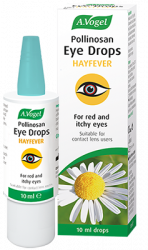Thunder hayfever
In the midst of summer when the weather is warm and humid thunder storms can become more regular. In a few minutes the weather switches from warm and bright, to grey and damp and then a grumble from the sky indicates it’s time to find shelter! So, this is bad news for people with thunder hayfever, a specific variety of hayfever that is influenced greatly by the weather.
Thunder hayfever is thought to be triggered by massive amounts of small pollen particles that are released into the air during thunderstorms. These small pollen particles are brought about by rapid changes in wind, temperature and humidity.

Wind
Pollen is usually quite concentrated near its source meaning parks and fields, as well as the countryside in general, are more likely to bring out hayfever symptoms. However, in order to distribute their pollen further afield, grass, weeds and trees rely on the wind.
Therefore, when thunderstorms turn the weather breezy, pollen can become more of an issue for hayfever sufferers because it is able to travel further. Also, the wind stirs up pollen so that it is no longer sitting at ground level meaning it is easily breathed in by unsuspecting hayfever sufferers!
Humidity
Whilst the rest of us huff and puff when there is rain about, this weather generally brings hayfever sufferers some relief from symptoms like congestion. That’s because, as I discussed in my blog ‘What effect does the weather have on hayfever?’, when rainfall occurs without thunder it washes pollen away meaning levels actually tend to fall.
However, during thunderstorms when the weather is both wet and humid, individual pollen grains can absorb moisture and then burst open causing hundreds more pollen particles to erupt. So, in this instance rain is not beneficial for hayfever sufferers and instead it contributes to severe hayfever symptoms like itchy skin, watery eyes and a runny nose.

How long will thunder hayfever last?
Unsurprisingly, the symptoms of your thunder hayfever will fluctuate depending on what the weather is doing. So, if thunderstorms are present, your hayfever symptoms probably will be too. This situation usually persists throughout the hayfever season which runs from March to October depending on what your trigger is.
It’s important to remember though, that not all thunderstorms, even on days with high pollen counts, will trigger thunder hayfever. Instead the conditions have to be right in terms of wind, temperature and humidity.
If you’d like some additional information on how thunder affects hayfever sufferers, have a look at my blog ‘Thunderous mix: could stormy weather make hayfever worse?’.

What can you do?
If you are suffering from thunder hayfever or, indeed, regular hayfever, there are a number of steps you can take to minimize the effects of pollen.
- First off, visit your doctor. As thunder hayfever is characterized by severe hayfever symptoms you may need a prescription of antihistamines or a corticosteroid spray to manage the problem.
- Hayfever treatments are known to be much more effective when they are taken over a period of time so rather than just taking your hayfever treatments when symptoms develop, take a course of them in the lead up to the hayfever season, during it and even when your symptoms begin to settle down.
- If pollen counts are high there are a number of steps you can take to control your symptoms. Keep the windows in your home shut during the day for example, wear wrap-around sunglasses if you go out, change your clothes when you return home (this stops the spread of pollen) and have a shower before you go to bed to prevent pollen reaching your pillow.
- Also, remember you can keep up to date with the pollen count in your area using our local pollen forecast. This has a 5 day pollen forecast for over 30,000 locations in the UK so, just type in the name of your nearest town or city and you’ll get information on how much grass, tree and weed pollen is nearby.
For further advice on how to deal with hayfever just have a look at my blogs. There you’ll find information on everything from how pets affect hayfever to unusual hayfever remedies. However, there are also a number of general pages about symptoms and treatments.

Herbal help for thunder hayfever
Here at A.Vogel we have a range of herbal remedies that can be used to address symptoms associated with thunder hayfever.
Our Moisturising Eye Drops for example, are useful if pollen turns your eyes watery, itchy and red. Also, when pollen affects the skin our Neem Cream is beneficial as it soothes itching and irritation.
On top of this we also have Pollinosan Hayfever Tablets. These can be used alongside other hayfever treatments and help to address a wide range of hayfever symptoms including sneezing, watery eyes and a blocked nose. These are particularly good as they are non-drowsy and therefore will not affect your day-to-day life.
So, if thunder hayfever is causing problems for you then this information and advice should help you deal with it effectively!





 Looking for help to ease those dry, tired and irritated eyes?
Looking for help to ease those dry, tired and irritated eyes?

